We may earn commissions when you buy from links on our site. Why you can trust us.
How to Pick the Best Surge Protector
Pretty much every home today has devices that can be impacted by electrical surges – TVs, computers, and even your kitchen appliances. However, even if you’ve taken the initiative to protect these products with a surge protector, there’s a pretty good chance that the surge protector you bought isn’t up to the task, either because the protection has worn out over time or it never really offered the protection it promised in the first place.
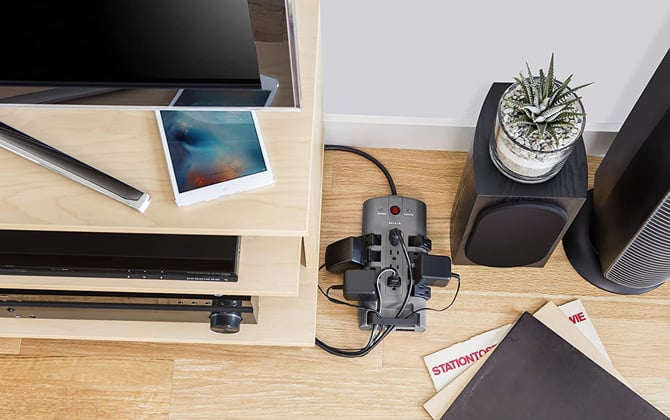
In the US, the standard household current is 120 volts. However, that power level can be affected by numerous factors both inside and outside your home, causing both dips and surges. Lightning strikes may be the cause that leaps to mind, but more common are surges from brownouts, blackouts, and power company equipment switches. Most of these surges aren’t significant enough to create issues for your electronics, but should a large surge come through without protection in place, your electronics can be permanently damaged. Even smaller surges can slowly damage electronics over time, leading to eventual failure. And manufacturer product warranties explicitly exclude this damage from coverage, so surge protection is a necessity in most homes.
I spoke with Stu Lipoff, Life Fellow at IEEE (The Institute of Electrical and Electronics Engineers), and Stan Levitsky, VP Ops & Product Development at Austere, a manufacturer of high-end surge protector products, and researched the topic extensively to understand what really should matter to consumers when we’re in the market for a surge protector. And it’s not all about the joules – the amount of excess power a surge protector can absorb – that manufacturers spend their effort advertising. Missing from the discussion is the surge protector’s equally important let-through rating (sometimes referred to as the clamping rating). Because while the joules will give you an approximate measure of how much surge energy the protector can divert before it reaches its end-of-life, the let-through rating tells you how big a surge the protector will let through before it starts diverting the excess energy. Too high a let-through rating and your devices may be damaged or fried before the protection kicks in – and all the joules in the world won’t make a difference at that point.
Read more: SwitchBot Lock Pro Review: The Smart Lock Solution for Renters
With this in mind, I reviewed the specs on dozens of models from numerous manufacturers to come up with a list of those I would recommend for our homes or office. Some manufacturers I excluded entirely because they were unable to provide any information (or inconsistent information) on the let-through ratings for their products (not a good sign). Many others have a combination of both well-performing and poorly-specced models, so I reviewed each one to ensure it would provide a strong level of protection. Where possible, I consulted the actual testing specs provided by Underwriters Laboratories (UL 1449) to confirm the information from the companies’ sites and marketing materials.
If you’re ready to check out my product picks, jump to the section below. But if you want to understand the nuances of how surge protectors work and how I picked the best, read on.
How surge protectors work
When you use a surge protector, internal components called Metal Oxide Varistors (MOV) redirect excess current away from your devices and into the ground line of your home (this is why you MUST use working three-prong outlets with surge protectors). Good surge protectors will provide both a low cut-off to prevent excess voltage from reaching your devices (the let-through voltage) and be able to absorb enough surge energy (the joule rating) to withstand one single large surge or multiple smaller surges. Bad surge protectors will not offer enough protection in one or both of these areas, and I’ve found plenty of bad ones out there.
Understanding the specs
In general, consumers should not have to dig into specs to know whether or not the products will provide the basic service it advertises. Unfortunately, with surge protectors, this is not the case.
Let-through voltage (aka clamping voltage)
The level at which the MOVs start to divert excess voltage is referred to as the let-through voltage (sometimes also referred to as clamping voltage in product specs) – the lower the let-through voltage, the better the protection. Let-through voltage is based on an Underwriters Laboratories standard (UL 1449) and is rated at increments of 330, 400, 500, 600, 800, and beyond (UL refers to it as the Voltage Protection Rating/VPR). There are separate ratings for each of the three wires in your household - Line to Neutral (L-N), Line to Ground (L-G), and Neutral to Ground (N-G) – though many manufacturers only provide a single value in their specs (if at all).
According to Lipoff, while appliances, computers, and other sensitive devices should be able to withstand short spikes under 400V with no damage, surge protectors with let-through ratings over 400V do not provide enough protection. On the flip side, a protector with a let-through voltage lower than 400V may subject the MOVs to a large number of unnecessary hits that reduce their life. Ultimately, manufacturers need to balance the amount of protection they offer with the wear on the components.
What makes things a little more complicated for evaluating surge protectors is that the UL testing is performed using a very high voltage current (6,000 volts) to measure let-through, equivalent to what a household may be exposed to from a nearby lighting strike – an extreme, yet very rare event. Surge protectors will start clamping at lower levels for less severe surges, which homes are more likely to experience from blackouts/brownouts and power station capacitor switching. Levitsky says that all of his company’s models begin clamping at around 280 volts in these scenarios, despite the official 500-volt let-through rating from their UL testing.
Buying advice
When shopping for surge protectors, look for models that are rated at 400V or lower across all three lines. 330V may not be necessary, but it offers an extra level of security for expensive AV equipment and the like. In my research, I found that many popular models of surge protectors have let-through ratings of 800V or higher – meaning your devices may be fried before protection ever kicks in.
If a manufacturer doesn’t provide the let-through value in their specs, it’s safe to assume the worst, especially among cheap or no-name products on Amazon or in big box stores. But even the best manufacturers have a range of protection in their models, so it’s not safe to just go by brand, either. When in doubt, contact the manufacturer’s customer support to get an answer before buying.
Joule rating
As MOVs redirect excess current away from your devices, they wear out. The lifetime of the MOVs in any given surge protector is measured in joules, which is the common spec you’ll see in manufacturer advertising. More expensive surge protectors will typically be rated for more joules and have a longer life expectancy. However, joule ratings should only be used as a rough indicator when comparing models since there is no testing standard for joule ratings, and factors like the let-through rating can significantly impact the life of the MOVs (better let-through protection will wear out MOVs faster).
Buying advice
Both Lipoff and Levitsky recommend at least 1,000 joules as a starting point. If you know your house has a risk of surges due to frequent power outages or above-ground power wires, or you are protecting expensive equipment, you probably should opt for something in the 2,000 to 4,000-joule range. Though even regular occurrences in your home, such as an HVAC unit or microwave cycling on and off, can create small surges, so no one is immune. Since there is no “meter” letting you know how much life your MOVs have left, experts advise replacing your surge protector about every three years or whenever it has been exposed to a lightning strike or power outage. As this can be impractical, it’s best to unplug surge protectors before the power comes back on.
Circuit breaker
Too many devices plugged into the same surge protector, a short circuit in one of your devices, or extreme events, such as lightning strikes, can cause an overload or overcurrent in your protector, creating a fire risk. Some surge protectors will have circuit breakers that cut power entirely to your devices in these scenarios. Manufacturers may explicitly mention circuit breakers; others may describe it as “overload” or “overcurrent” protection.
Buying advice
Most brand-name surge protectors offer a circuit breaker, so those that do provide an extra level of protection that is worth looking for.
EMI and RFI noise filtering
Electro-Magnetic Interference (EMI) and Radio Frequency Interference (RFI) are electronic disruptions within your power lines that can be created by devices within your home, such as a vacuum cleaner or other large appliance. And noise can also be generated outside the home. According to Austere’s Levitsky, “Powerline stability is becoming less stable because of solar…Neighbor’s solar panels can create a fair amount of noise in the powerlines, generating issues for longevity and performance of audio and video.”
Lipoff at IEEE notes that “Line noise is less likely to damage equipment, but can cause devices to malfunction – or, in the case of computers, to cause data errors…it is useful to buy surge protectors that also include line noise filtering in addition to overvoltage surge protection.”
Buying advice
While not critical, noise filtering is a nice-to-have, and most better surge protectors offer it. Look for models that offer it if it will be used to protect computers or AV equipment.
Protection-failure light indicator and auto-shutoff
Sooner or later, the life of your MOVs will be used up, and you will no longer have surge protection for your devices. At a bare minimum, your surge protector should have an indicator light when this occurs (and almost all do). But since many of us stuff surge protectors under desks or behind cabinets, that light can be easy to miss. So, as an extra safety step, some surge protectors will shut off power entirely to the outlets when the MOVs expire. Brands like Austere don’t offer auto-shutoff but will send you reminder emails for when it is time to consider replacing your surge protector if you register your device after purchase.
The protection light will also notify you of an improperly installed surge protector (e.g., plugging it into a two-prong outlet with an adapter) or issues with your home wiring that may be preventing a proper ground.
Buying advice
In most situations, shutting off power entirely is a better solution than simply having a light – the inconvenience of no power is better than the inconvenience of fried devices. Some manufacturers, like Tripp Lite, will call this feature out explicitly on devices that have it. Others may have proprietary names, like Belkin’s “Power Safety Shut Down.” Either way, I would strongly recommend it.
That said, there may be circumstances where keeping power flowing is the better option, even if it is unprotected. For example, you wouldn’t want a refrigerator to lose power or a router that controls your alarm system, especially if you are on vacation and can’t replace the surge protector quickly.
Read more: Smart Home, Hidden Dangers: Is Your IoT Device a Hacker's Best Friend?
UL and ETL safety certification
To ensure your surge protector offers the protection it claims to and will operate without the risk of shock or fire, surge protectors can be certified by Underwriters Laboratories (UL) or Intertek ETL to confirm that they meet US safety standards, as defined by UL 1449. Manufacturers will usually mention UL or ETL certification in their marketing materials, and the physical product will have a UL or ETL sticker on the bottom.
Buying advice
You should only buy a surge protector that has Underwriters Laboratories (UL) or Intertek ETL certification. Any product from a major brand should be certified – if in doubt, ask before you buy. If you buy a product and don’t see the sticker, that can be cause for concern.
Number and type of plugs and USB ports
There are numerous configurations for surge protector outlets, from tiny portable models with a couple of plugs to hefty units with a dozen or more plugs, along with protection for coax, ethernet, phone wires, and USB ports. In general, more plugs is better (no one wants to run out), though there’s no point in paying for connections you’ll never need, like phone jacks if you don’t have a landline or coax if you don’t have a roof antenna running directly into your TV. And keep in mind that large power bricks can cover multiple outlets if the outlets are not well-spaced across the surge protector.
Since so many devices now operate using USB, integrated USB ports on the surge protector can come in handy. But be aware that only some models supply enough power to fast charge your devices, and the power is often shared across the USB ports, so charging multiple USB devices will supply less power to each of them. In many cases, you may be better off plugging your USB device into one of the 120V outlets on the surge protector using a USB adapter.
Buying advice
Figure out what you need before buying to make sure you have enough of the right outlets and you’re not paying for extras you won’t use.
Consumer reviews
Surge protectors are one of the electronic products where you’re better off ignoring positive user reviews. Because large surges are a relatively rare event, most users will never really know if their surge protector is protecting them or not (I’ve seen plenty of products out there with 800V let-through ratings that users rave about, even though there’s a good chance an actual surge would fry their devices). On the other hand, if a product is getting a large number of negative reviews, that’s definitely a concern.
Buying advice
Take all user reviews with a huge grain of salt. Focus on the product’s specs instead.
Equipment warranties
If a surge protector offers a $100,000 connected equipment warranty, you’re good, right? Not so fast. Many companies offer warranties that will reimburse you for equipment damaged by a surge, but there are a number of conditions that need to be met, and you have little say over the company’s final decision. At a minimum, you will need to send the surge protector back to the company for evaluation at your expense. If they determine that it is working properly, you’re out of luck, even if a surge did get through under the protector’s let-through cut-off, for example. You may also need to send the damaged equipment to them for evaluation – so you could be bearing the costs of shipping off a damaged TV, only for them still to determine you’re not covered. And while it is impossible to analyze the accuracy of user reviews, many of the negative ones do relate to the failure of companies to pay out warranties.
Buying advice
There are so many unknowns in the warranty process that it’s best just to ignore the connected equipment warranty as a buying consideration. Though still be sure to register your surge protector after purchase to make it easier to file a claim, should it ever come to that.
Recommended surge protectors
After reviewing the detailed specs for dozens of different models across a range of price points, confirming information with companies, and pouring through more documentation on safety standards and testing than I ever care to repeat, these are the surge protectors I would recommend for most people.
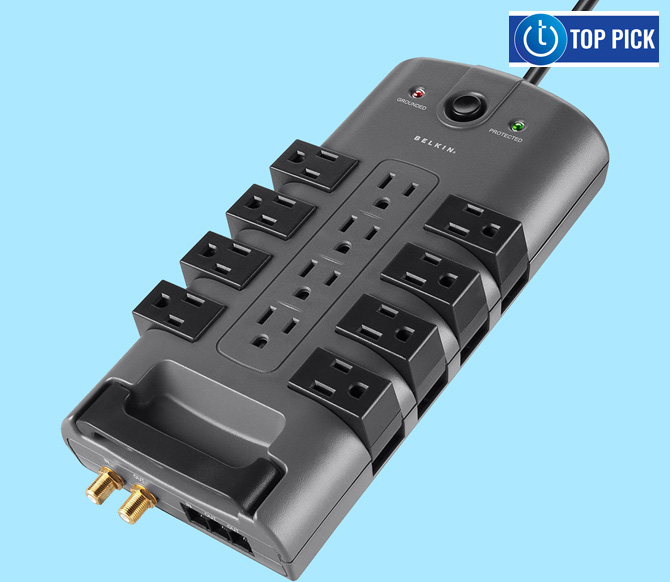
Top Pick: Belkin 12-Outlet Pivot-Plug Surge Protector (BP112230-08)
The Belkin 12-Outlet Pivot-Plug Surge Protector offers the best-rated overall protection of any model I found, combining high joules with a very low UL-tested let-through rating. It also includes an integrated circuit breaker and auto-shutoff that cuts power to your devices when it can no longer offer surge protection. Besides having 12 outlets, coax, and telephone protection, eight of the twelve outlets can pivot sideways, making more room for bulky power bricks.
While it doesn’t have integrated USB charging ports, it’s easy enough to use a power adapter to fast charge your devices. It doesn’t win any points for attractiveness, so this is definitely a device to place under or behind your furniture.
Joules: 4,320 joules
Let-through: (L-N/L-G/N-G): 330/400/400
Outlets: 12 plugs, coax, RJ-11 telephone
Circuit breaker: Yes
Protection-failure light indicator: Yes
Auto-shutoff: Yes
Price: $42.99
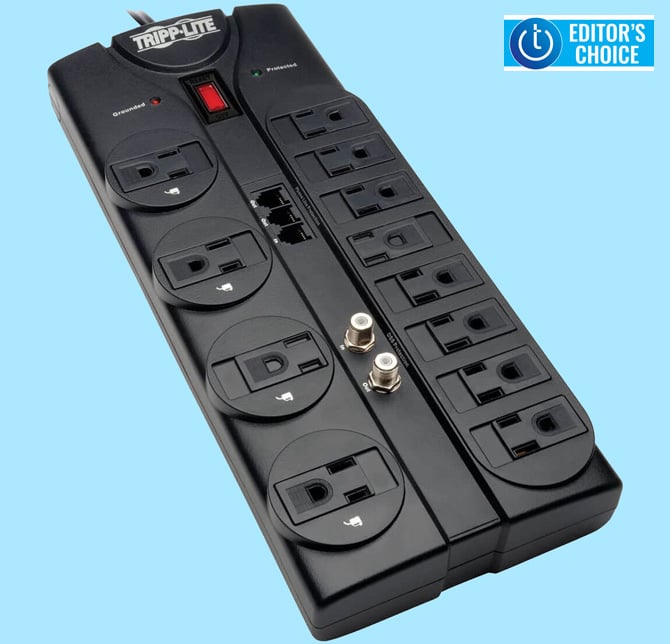
Editor's Choice: Tripp Lite 12-Outlet Surge Protector (TLP1208TELTV)
The Tripp Lite 12-Outlet Surge Protector is a close second to the Belkin in protection, suffering only from a slightly lower 2,880-joule capacity (which is still quite respectable) and a slightly higher price of around $49. The outlets don’t swivel, but four are widely spaced to accommodate transformers. I’m also a fan of the right-angle plug on the power cord – not found on the Belkin – that allows easier placement behind furniture. Unfortunately, it also falls squarely in the function-over-form school of design, so best kept out of sight.
Joules: 2,880 joules
Let-through: (L-N/L-G/N-G): 330/400/400
Outlets: 12 plugs, coax, RJ-11 telephone
Circuit breaker: Yes
Protection-failure light indicator: Yes
Auto-shutoff: Yes
Price: around $50
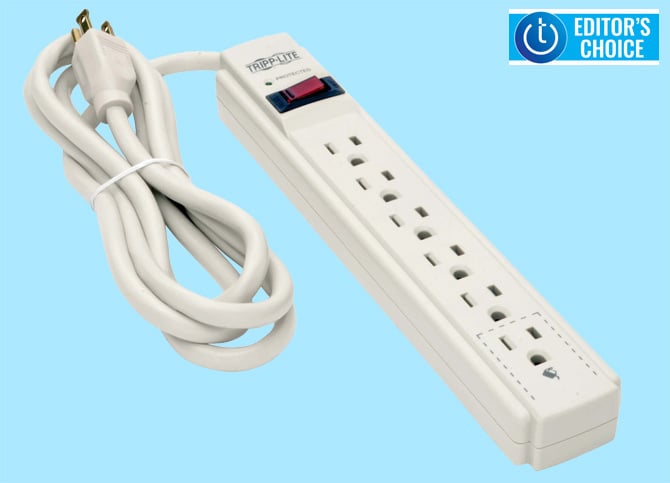
Best Budget Surge Protector: Tripp Lite 6-Outlet Surge Protector (TLP606)
Too often with budget models, you sacrifice both features and protection. This is the category where I found numerous products with 800V or higher let-through ratings – much too high. The Tripp Lite 6-Oulet Surge Protector, on the other hand, is UL rated at a product-safe 400V. And while it only has 790 joules of protection, that should last years for most homes, and there is an automatic cutoff for when the joules run out, so your equipment won’t be left unprotected. A perfect choice for college dorm rooms.
Joules: 790 joules
Let-through: (L-N/L-G/N-G): 400/400/400
Outlets: 6 plugs
Circuit breaker: Yes
Protection-failure light indicator: Yes
Auto-shutoff: Yes
Price: around $17
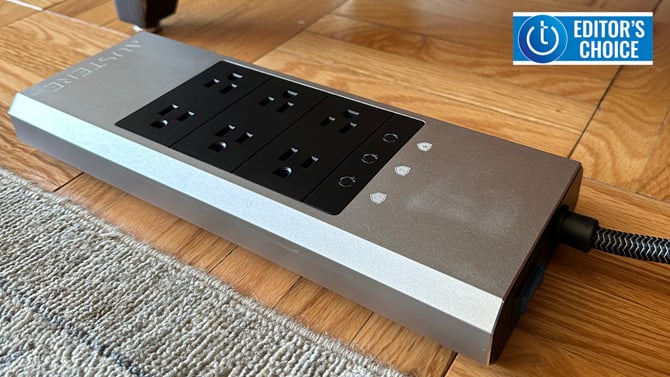
Best Designed Surge Protector: Austere VII Series Surge Protector
Most surge protectors have a face that only their electrical engineer mothers could love; cheap black (or white!) plastic crudely molded into a chunky rectangular box. And that’s fine if you’re hiding it behind your sofa. But if your surge protector will be in plain sight, the Austere VII Series, with its brushed aluminum case, modern design aesthetic, and woven-fabric-covered power cable, is far and away the most attractive out there. In keeping with its modern design, the Series VII is also the only model I found with a 45-watt Power Delivery USB-C port, in addition to two USB-A and two USB-C ports, each rated at up to 12 watts with a maximum output of 25 watts across all four.
The Series VII offers 4,000 joules, which should last you a very long time, though, disappointingly, it does not have auto-shut-off for when those joules run out (warning you instead via the protection light). It is also ETL rated at 500V let-through, which is higher than ideal. Despite this rating, the company confirmed to me in person that Series VII (and all other Austere surge protection products) will begin clamping at 280V under most typical household surge scenarios.
Joules: 4,000 joules
Let-through: (L-N/L-G/N-G): 500/500/500
Outlets: 8 plugs, 2 USB-A (up to 12W), 2 USB-C (up to 12W), USB-C (45W PD)
Circuit breaker: Yes
Protection-failure light indicator: Yes
Auto-shutoff: No
Price: $199.99 (six outlets), $229.99 (eight outlets)
Updated on 8/9/2024 with current product picks and pricing.
[Image credit: Techlicious, Belkin, Eaton]
Josh Kirschner is the co-founder of Techlicious and has been covering consumer tech for more than a decade. Josh started his first company while still in college, a consumer electronics retailer focused on students. His writing has been featured in Today.com, NBC News and Time.
Discussion 
Should I have a surge protector between my UPS and equipment?
A UPS will have surge protection built-in. Though like surge protectors, specs will vary for these devices as well. The advice here is to buy a UPS with a high level of surge protection - I see models out there with as low as 180 joules, which is basically nothing. And since these devices aren’t rated under UL 1449, I don’t know if there is any way to judge what their let-through rating equivalent would be.
So unless you really need a UPS for a desktop or similar device where you need time to power down, you are better served by a surge protector for most uses.
You should not daisy-chain a surge protector and a UPS, either plugging the UPS into the surge protector or vice versa. Manufacturers explicitly warn against it and doing so can void the warranty.
Is whole house protection a good option instead of multiple surge protection devices?
A whole house surge protector can be an excellent way to protect all of the electrical equipment in one go. However, they can be more expensive to purchase and install and will still need to be replaced every 5 years or so, depending on the model and your home’s power conditions.
Keep in mind that there are better and not as good whole house solutions. Let-through ratings apply to whole house devices, too, so follow the same advice as in the article above. I see many whole house products on the market with inadequate protection (upwards of 1500V!). You’ll also want to ensure you have both Type 1 (external power line surge protection) and Type 2 (interior circuitry surge protection).
At the end of the day, for the best protection, you should layer a whole house system with individual surge protectors for your most valuable/sensitive electronics.
In conjunction with adding a third bedroom to my TX house just before Beryl, the electrician added a whole house surge protector. This is the first invoice I’ve ever had for Any kind of work that didn’t set out the price of each component; and in this case, I was given NO information as to exactly what was installed - I’ll have to check when I visit again next spring. My question is (since I’m being asked it by neighbors there) about how much should a whole house surge protector cost? The unit itself (a range); I know the labor/installation costs would be all over the map depending on where you lived. This house is about 1200 sq.ft.
Thank you for actually explaining the clamping voltage part for them! It is VERY rare to find someone who has included that info on their “best surge protectors” lists… It seems they just either copy what they see on other sites or just look at the best selling on Amazon that have good reviews without knowing jack squat about what even makes a good surge protector or not. Just bought 2 of them through your link because you deserve to get the commission ![]() Looking forward to reading your other posts now too!
Looking forward to reading your other posts now too!
Hi Thomas,
I’m glad you found the article helpful. This was one of the more difficult stories I’ve written and required quite a bit of research into expert sources and manufacturers (many of home provide spotty or inconsistent information) to get this right.
Best,
Josh
Hmm it seems that the belkin and trip-lite in the $50 range doesn’t protect from surges too well, several complaints on amazon and the company doesn’t honor the warranty. (apparently they will not pay out and say that nothing is wrong or not their fault) check the reviews. Paying out that kind of money for something that doesn’t work is not good. Maybe you received a good one? to test. Even the most expensive one has some very bad reviews. I don’t mind paying a little more if it is a quality product but my guess is china made and quality control is terrible.
Hmm it seems that the belkin and trip-lite in the $50 range doesn’t protect from surges too well, several complaints on amazon and the company doesn’t honor the warranty. (apparently they will not pay out and say that nothing is wrong or not their fault) check the reviews. Paying out that kind of money for something that doesn’t work is not good. Maybe you received a good one? to test. Even the most expensive one has some very bad reviews. I don’t mind paying a little more if it is a quality product but my guess is china made and quality control is terrible.
(note not sure my comment made it thru the last time so I am trying again)
It seems that the belkin and trip-lite in the $50 range doesn’t protect from surges too well, several complaints on amazon and the company doesn’t honor the warranty. (apparently they will not pay out and say that nothing is wrong or not their fault) check the reviews. Paying out that kind of money for something that doesn’t work is not good. Maybe you received a good one? to test. Even the most expensive one has some very bad reviews. I don’t mind paying a little more if it is a quality product but my guess is china made and quality control is terrible.
I have experience with surge suppressors dating to the 1980s. The one most important feature to review when purchasing a surge protector is the clamping time. One that clamps in less than 1 millisecond is adequate, but preferably instantaneous. That aspect hasn’t changed over time.
Hi Al,
Unfortunately, there is no standard measurement of response time and it can’t be used to compare across devices (if a company reports response time at all). For this and a variety of other reasons, the Institute of Electrical and Electronic Engineers (IEEE) says that this is a misleading approach and discourages using response times as a method of comparison. Instead, let-through voltage is the better data point. See: https://www.surgesuppression.com/images/DotNetSite/TechPapers/ResponseTimeforSurgeProtectiveDevicesR060705.pdf
Also see Schneider Electric’s similar analysis and conclusion: https://media.distributordatasolutions.com/schneider2prod/2018q2/8949268504658cbb7a7285151f455d5de7e7209e



















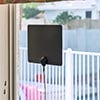
From holla on April 14, 2023 :: 2:11 pm
I have an old surge protector protecting a lot of “stuff” incldg 2 PCs 1 printer,
I have at least 6 SP in various states of use/unused bc it’s too complicated to choose the correct plug for usage.
I read it’s imperative to have the SP w/UPS capability.
Or not.
Reply
From Josh Kirschner on April 14, 2023 :: 4:07 pm
Both a surge protector and UPS will protect your devices against surges. A UPS offers the added benefit of short-term battery backup for brownouts and blackouts, which would give you time to save any work on a desktop computer, as well as voltage regulation (on some models) for sensitive devices, such as servers. However, a UPS will cost a lot more and there’s little benefit to the battery backup for devices other than desktops.
Reply